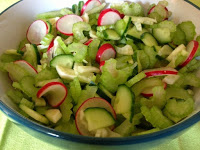Writer considers salad a wasteful luxury, and not all that nutritious

 |
Salads should be considered a “resource-hungry luxury” instead of a staple because they offer little nutritional value, require “precious crop acreage” to grow, requires fossil fuel and refrigeration to ship, is the top source for food waste and a top transporter of food born illnesses, Tamar Haspel writes for The Washington Post .
“As the world population grows, we have a pressing need to eat better and farm better,” Haspel writes.
Haspel notes that while she has pointed out problematic foods such as almonds, for their water use; corn, for the monoculture it encourages; and beef, for greenhouse gases from cattle, “none of them is a clear-cut villain,” unlike salad, which “has almost nothing going for it.” She backs up her claim with these arguments:
Salad is mostly water: Haspel writes that a nutrient quality index that rates foods based on how much of 27 nutrients they contain per 100 calories found “four of the five lowest-ranking foods (by serving size) are salad ingredients: cucumbers, radishes, lettuce and celery. (The fifth is eggplant.)” This is because they are 95 to 97 percent water, unlike other more nutritious vegetables like the sweet potato, which is only 77 percent water. “A head of iceberg lettuce has the same water content as a bottle of Evian (1-liter size: 96 percent water, 4 percent bottle) and is only marginally more nutritious.”
Salad fixings are expensive, with little nutrition: “The makings of a green salad — say, a head of lettuce, a cucumber and a bunch of radishes — cost about $3 at my supermarket,” she writes. “For that, I could buy more than two pounds of broccoli, sweet potatoes or just about any frozen vegetable going, any of which would make for a much more nutritious side dish to my roast chicken.”
Eating less salad saves the planet: “When we switch to vegetables that are twice as nutritious — like those collards or tomatoes or green beans — not only do we free up half the acres now growing lettuce, we cut back on the fossil fuels and other resources needed for transport and storage.”
Salad add-ins can make you fat: “Lots of what passes for salad in restaurants is just the same as the rest of the calorie-dense diabolically palatable food that’s making us fat, but with a few lettuce leaves tossed in. I won’t be the first to point out that items labeled ‘salad’ at chain restaurants are often as bad, if not worse, than pastas or sandwiches or burgers when it comes to calories.”
“Take Applebee’s, where the Oriental Chicken Salad clocks in at 1,400 calories, and the grilled version is only 110 calories lighter. Even the Grilled Chicken Caesar, the least calorific of the salads on the regular menu, is 800 calories. Of course, salad isn’t always a bad choice, and Applebee’s has a selection of special menu items under 550 calories (many chain restaurants have a similar menu category).”
Lettuce is the top source of vegetable food waste and food borne illnesses: “It’s the top source of food waste, vegetable division, becoming more than 1 billion pounds of uneaten salad every year,” and “According to the Centers for Disease Control (and Prevention), green leafies accounted for 22 percent of all food-borne illnesses from 1998-2008.” (Leafy vegetables also include cabbage, spinach and other kinds of greens.)
Haspel says she loves a good salad as much as anyone, and recognizes that as a filler it has kept her from eating too much calorie-dense food, but she concludes, “As we look for ways to rejigger our food supply to grow crops responsibly and feed people nutritiously, maybe we should stop thinking about salad as a wholesome staple, and start thinking about it as a resource-hungry luxury.”